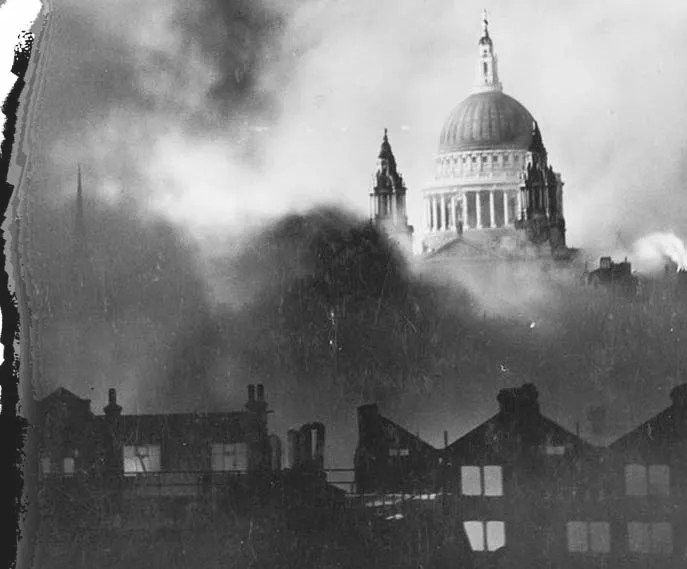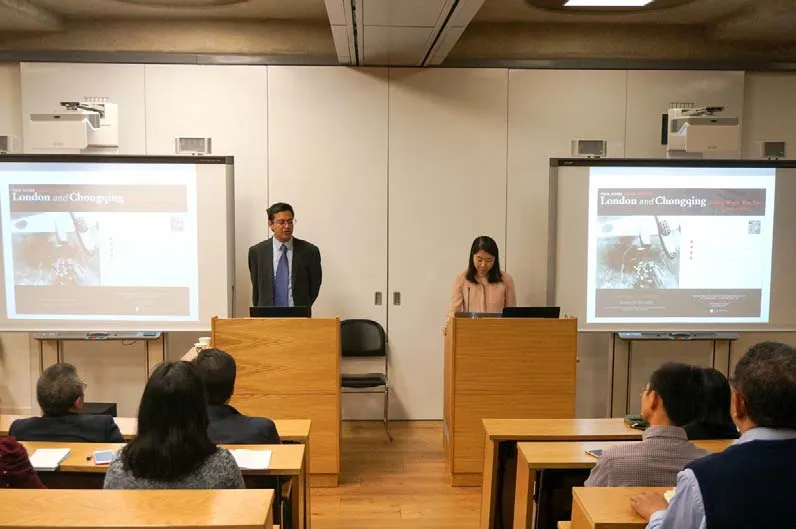双城记忆:伦敦·重庆大轰炸
2018-10-23杨艳
□ 文/本刊记者 杨艳

1938年2月至1944年12月,侵华日军对重庆实施了6年10个月的狂轰滥炸,历史上称“重庆大轰炸”。同一时期,1940年9月至次年5月,相隔万里的伦敦,也在遭受德军实施的战略轰炸……
70余年后,一场名为“共度时艰:伦敦·重庆大轰炸”的图片展,以“大轰炸”为主线,将二战时期中英两国战时首都重庆与伦敦联系起来,展示了两城遭受德日法西斯狂轰滥炸、两国人民的战时友谊,以及军民的顽强不屈。

“共度时艰:伦敦·重庆大轰炸”图片展在伦敦展出。

在伦敦展出期间,参观者络绎不绝。
一场中英跨国合作的展览
这场由重庆图书馆和英国牛津大学共同主办的“共度时艰:伦敦·重庆大轰炸”图片展已于今年4月30日在英国牛津大学中国中心展出,3个月后移回重庆,并于8月15日日本宣布无条件投降73周年之际,在重庆图书馆继续展出。
历史上,伦敦大轰炸、重庆大轰炸、柏林大轰炸与东京大轰炸,被称为二战时期的四大轰炸。重庆与伦敦,两座城市经历了相同的灾难。展览上,134张图片,再现二战时期两地人民在残酷的战争面前流露的坚韧,如同一条精神纽带,牵动每一个参观者的神经。
“今年是重庆大轰炸80周年,也是英国牛津大学中国中心与重庆图书馆开展合作交流10周年。”重庆图书馆馆长任竞表示,双方共同举办这场展览,既为了让第二次世界大战的史实在中西方主流社会中被正确认识和广泛传播,又以展览为契机,持续深化中英两国的亲密伙伴关系,拓展双方人文合作的新领域。
缘起一场国际学术交流活动
此次展览最早缘于10年前的一次国际学术交流活动。2009年,长期致力于中国抗日战争史的研究,创办了牛津大学中国抗日战争研究中心,并出版《中国,被遗忘的盟友》一书的拉纳·米德教授,受邀到重庆参加学术研讨会。他在考察重庆大轰炸等抗战遗址后,提议能否与重庆方面合作,对重庆大轰炸和伦敦大轰炸进行比较研究。
直至2013年,中日战争国际共同研究第五次会议在重庆召开,当初的想法变成了现实。牛津大学中国中心和西南大学、重庆图书馆签订战略合作框架协议,双方在人员交往、文献搜集、学术研究三方面展开了深入交流和合作。于是,“共度时艰:伦敦·重庆大轰炸”图片展作为合作项目之一,就正式启动。
“重庆大轰炸”图片在伦敦反响热烈
整个展览分为“二战时期的中英同盟关系”“伦敦大轰炸”“重庆大轰炸”“二战胜利”4个部分。据展览策展人,重庆图书馆研究咨询中心主任唐伯友介绍,在牛津大学只展出了“伦敦大轰炸”“重庆大轰炸”两个部分。自开展后,观展的有牛津大学师生、学者、当地市民,络绎不绝。
“国外民众对重庆大轰炸以及中国人民抗日战争史知之甚少,所以他们对重庆大轰炸的图片表现出极大的兴趣,其中就有不少参观者在一张写有标语‘愈炸愈强’的经典照片前合影留念。”唐伯友说,因展览反响热烈,原本计划于6月底结束的展览,延展至7月底才结束。
在伦敦学术界,此次展览也受到不少关注。展出期间,牛津大学中国中心就中国抗战史主题举办了学术研讨会。“在会议上,我们结识了国外同一领域的学者,从他们口中,了解到国外对中国抗战史的研究情况,这对我们往后的研究以及中英双方的深入交流与合作起到很大作用。”

关于中国抗战史的学术研讨会在牛津大学中国中心举行。
50余张图片首次在重庆出现
“本次展览有50余张照片是首次与重庆市民见面。”唐伯友说,筹备之初,项目组收到牛津大学中国中心提供的伦敦大轰炸历史照片,共计300余张;重庆中国三峡博物馆、重庆图书馆、重庆市档案馆等机构提供的大轰炸照片上万张。其中伦敦大轰炸的照片皆典藏于英国战争博物馆。
为了让整个展览凸现人民的乐观与坚韧,选片之初,主办方也颇费心思。“此次展出不再主要展示战争的惨状,而是以战时人民积极的生活状态为‘主角’,这一想法得到了中英双方的一致赞同。”唐伯友说。
记者在展览现场看到不少此类照片,如一张在伦敦北区防空洞里,避难的市民围在一台留声机前收听消息,神情自若;还有一张无家可归的孩子在伦敦磨坊山约翰基布尔教堂享受茶点,笑容依旧。类似的照片在“重庆大轰炸”部分也能看到:日机轰炸重庆后,城中小什字一带变成废墟,市民积极参与灭火,让人印象深刻。
据介绍,为让更多人了解伦敦与重庆大轰炸的基本史实,该展览还将在国内外其他城市和高校进行巡展。截止目前,项目组已收到香港树人大学、西南大学等高校承办巡展的意向。

50余张图片首次在重庆展出。
The Bombing of Chongqing refers to the terror bombing operation conducted by the Japanese invaders from February 1938 to December 1944, which even lasted for 6 years plus 10 months. During the same period,London, thousands of miles away from China, was also suffering strategic bombing by the German army from September 1940 to May 1941.
Over 70 years later, a photo exhibition entitled “Tiding Over Hard Times Together∶ The Chongqing Bombing and The London Blitz” linked the Chinese and British wartime capitals Chongqing and London during World War II through the main line “big bombing”, showing the indiscriminate bombing on the two cities by the German and Japanese fascists and the wartime friendship between the two peoples, as well as the unyielding spirit of the militaries and civilians.
A Cross-border Cooperation between China and Britain
The photo exhibition of “Tiding Over Hard Times Together∶ The Chongqing Bombing and The London Blitz” co-sponsored by the Chongqing Library and the University of Oxford was first held at the University of Oxford China Center on April 30th this year, and moved back to Chongqing three months later. On the occasion of the 73rd anniversary of the unconditional surrender of Japan on August 15, it continued to be exhibited in the Chongqing Library.
Historically, The Chongqing Bombing, the London Blitz, the Bombing of Berlin in World War II and the bombing of Tokyo were known as the Four Bombings of World War II. Among them,Chongqing and London have experienced the same disasters and sufferings. In the exhibition, 134 pictures and photos have showed the great tenacity of the peoples facing the brutal war during the World War II. It is like a spiritual bond that tugs the nerves of every visitor.
“This year marks the 80th anniversary of the Chongqing Bombing. It is also the 10th anniversary of the cooperation between the University of Oxford China Center and the Chongqing Library.”Chongqing Library Director Ren Jing said, the exhibition jointly held by the two sides will make the historical facts of the World War II correctly understood by and widely disseminated in the mainstream society of China and the West. Besides, it is also an opportunity to continuously deepen the intimate partnership between China and Britain and expand the new field of bilateral cultural cooperation.
Originating from An International Academic Exchange
The exhibition originated from an international academic exchange event 10 years ago. In 2009, Rana Mitter, the author of Forgotten Ally∶ China’s War with Japan who has devoted himself to the study of China’s anti-Japanese war history and founded the Oxford University Research Center of the Chinese Anti-Japanese War, was invited to participate in academic seminars in Chongqing. After investigating the the Chongqing bombing ruins and other anti-war sites, he proposed whether he could cooperate with Chongqing to conduct a comparative study on the Chongqing Bombing and the London Blitz.
Until 2013 when the Fifth International Joint Research Conference on Sino-Japanese War was held in Chongqing, the original idea became a reality. the University of Oxford China signed a framework agreement on strategic cooperation with Southwest University and Chongqing Library.The two sides conducted in-depth exchanges and cooperation in personnel exchanges, literature collection, and academic research. As a result,the photo exhibition “Tiding Over Hard Times Together∶ The Chongqing Bombing and The London Blitz” was officially launched as one of the cooperation projects.
The Photos of Chongqing Bombing Evoked Strong Public Responses in London
The exhibition is divided into four parts∶ “China-UK Alliance during World War II”, “the London Blitz”, “the Chongqing Bombing” and “the Victory of the World War II”. According to Tang Boyou, the curator of the exhibition and director of the Chongqing Library Research and Consulting Center, only two parts, namely “the London Blitz” and “the Chongqing Bombing”, have been shown at University of Oxford. Since its launching, a number of teachers,students and scholars from Oxford and local citizens came for a visit.
“Foreign people know little about the history of the Chongqing Bombing and the Chinese People’s War of Resistance against Japan, so they showed great interest in the pictures and photos of the Chongqing Bombing. Many of them took a group photo in front of a classic photo with the slogan “Fighting Stronger for the Heavier Bombing”. Tang Boyou said, due to the enthusiastic response of the exhibition, the exhibition originally planned to conclude at the end of June was extended until the end of July.
In the academic world of London, the exhibition also received a lot of attention. During the exhibition, the University of Oxford China Center held an academic seminar themed on the history of Chinese Sino-Japanese Warfare.“At the meeting, we met scholars from the same field abroad and learned about the foreign study of the history of Chinese Sino-Japanese Warfare. It will play a significant role in our future research and the in-depth exchanges and cooperation between China and the UK.”
Over 50 Pictures Appeared in Chongqing for the First Time
“There are more than 50 pictures and photos appeared in this exhibition for the first time and met with Chongqing citizens.” Tang Boyou said, the project team received a total of more than 300 photos of the London Blitz history provided by the University of Oxford China Center at the beginning of the preparation; Over ten thousand photos were provided by Chongqing China Three Gorges Museum, Chongqing Library, Chongqing Archives and other institutions. Among them, the photos of the London Blitz were all collected in the British War Museum.
In order to make the whole exhibition highlight the optimism and tenacity of the people, the organizers also tried to rack brains at the beginning of the film selection. “This exhibition no longer takes showing the horror and misery of war as its main purpose, but makes the active life in wartime a main line.This idea has been unanimously endorsed by both China and Britain.” Tang Boyou said.
The reporter saw many photos like these at the exhibition site. One of them describes a shelter in the North District of London, where the citizens seeking refuge are crowding in front of a phonograph, listening to the news with an easy grace; Another one shows a homeless child is enjoying refreshments at the John Kibble Church in the Mill Hill in London, and his simile is brightly shining. Similar photos can be seen in the Chongqing Bombing section∶ After the Japanese bombing of Chongqing, Xiaoshizi became a ruin, and the citizens was actively fighting the fire, which is really impressive.
According to reports, in order to make more people understand the basic historical facts of the London Blitz and the Chongqing Bombing, the exhibition will also tour in other cities and universities at home and abroad. Up to now, the project team has received the letter of intent of the Hong Kong Shue Yan University, the Southwest University and other universities to undertake the tour.
